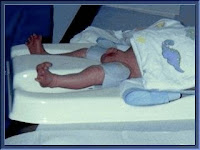October 26, 2009
Two of my physics professors at Queen's University (Dr. Stewart & Dr. McKee) were the original developers of Positron Emission Tomography (PET) for medical applications. They and a number of other Queen's physicists also worked on improving the accuracy of fMRI for observing metabolic activity within the human body.
As a graduate student working in the Dept. of Epidemiology, I was approached by a group of nurses who were attempting to organize a protest against male infant circumcision in Kinston General Hospital. They said that their observations indicated that babies undergoing the procedure were subjected to significant and inhumane levels of pain that subsequently adversely affected their behaviours. They said that they needed some scientific support for their position. It was my idea to use fMRI and/or PET scanning to directly observe the effects of circumcision on the infant brain.
The operator of the MRI machine in the hospital was a friend of mine and he agreed to allow us to use the machine for research after normal operational hours. We also found a nurse who was under intense pressure by her husband to have her newborn son circumcised and she was willing to have her son to be the subject of the study. Her goal was to provide scientific information that would eventually be used to ban male infant circumcision. Since no permission of the ethics committee was required to perform any routine male infant circumcision, we did not feel it was necessary to seek any permission to carry out this study.
 We
tightly strapped an infant to a traditional plastic "circumrestraint" using
Velcro restraints. We also completely immobilized the infant's head using
standard surgical tape. The entire apparatus was then introduced into the MRI
chamber. Since no metal objects could be used because of the high magnetic
fields, the doctor who performed the surgery used a plastic bell ("Plastibell")
with a sterilized obsidian bade to cut the foreskin. No anaesthetic was used.
We
tightly strapped an infant to a traditional plastic "circumrestraint" using
Velcro restraints. We also completely immobilized the infant's head using
standard surgical tape. The entire apparatus was then introduced into the MRI
chamber. Since no metal objects could be used because of the high magnetic
fields, the doctor who performed the surgery used a plastic bell ("Plastibell")
with a sterilized obsidian bade to cut the foreskin. No anaesthetic was used.The baby was kept in the machine for several minutes to generate baseline data of the normal metabolic activity in the brain. This was used to compare to the data gathered during and after the surgery. Analysis of the MRI data indicated that the surgery subjected the infant to significant trauma. The greatest changes occurred in the limbic system concentrating in the amygdala and in the frontal and temporal lobes.
